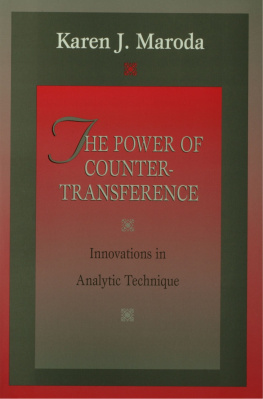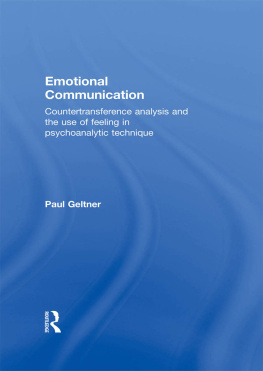The Ego and Analysis of Defense
The Ego and Analysis of Defense
Second Edition
PAUL GRAY

Published in the United States of America
by Jason Aronson
An imprint of Rowman & Littlefield Publishers, Inc.
A wholly owned subsidiary of
The Rowman & Littlefield Publishing Group, Inc.
4501 Forbes Boulevard, Suite 200, Lanham, Maryland 20706
www.rowmanlittlefield.com
PO Box 317; Oxford; OX2 9RU, UK
Copyright 2005 by Rowman & Littlefield Publishers, Inc.
All rights reserved. No part of this publication may be reproduced, stored in a retrieval system, or transmitted in any form or by any means, electronic, mechanical, photocopying, recording, or otherwise, without the prior permission of the publisher.
British Library Cataloguing in Publication Information Available
Library of Congress Cataloging-in-Publication Data
Gray, Paul, 19182002
The ego and analysis of defense / Paul Gray.2nd ed.
p. ; cm.
Includes bibliographical references and index.
ISBN: 978-0-7657-0336-1
1. Psychoanalysis. 2. Ego (Psychology) 3. Conflict (Psychology) 4. Defense mechanisms (Psychology) 5. Psychotherapist and patient.
[DNLM: 1. Ego. 2. Defense Mechanisms. 3. Physician-Patient Relations. 4. Psychoanalytic Theory. 5. Psychoanalytic Therapy. WM 460.5.E3 G781e 2005] I. Title.
RC504.G676 2005
Printed in the United States of America
 The paper used in this publication meets the minimum requirements of American National Standard for Information SciencesPermanence of Paper for Printed Library Materials, ANSI/NISO Z39.48-1992.
The paper used in this publication meets the minimum requirements of American National Standard for Information SciencesPermanence of Paper for Printed Library Materials, ANSI/NISO Z39.48-1992.
To Gerda
Contents
by Dr. Marianne Goldberger
by Dr. Samuel Ritvo
Foreword to the
Second Edition
The happy event of this publication of the second edition of Paul Grays landmark 1994 book has been saddened by his death just four months ago. His vital and gentle presence as mentor, teacher, and consultant will be sorely missed. He leaves a space that cannot be filled.
This book, together with the series of seminal journal articles he published over the past 30 years are a testament to Grays pioneering intellect. They have stirred up enormous interest and controversy about the most important part of psychoanalytic technique: how the analyst listens. This second edition of Grays book contains four additional papers, two of them known to his readership from their publication in 1996 and 2000. The two others contain ideas not published before.
In the 1996 paper, Undoing the Lag in the Technique of Conflict and Defense, Gray reconsidered the fact that analytic technique has not integrated Freuds radical revision of the role of anxiety in neurosis formation. To explain this lag, Gray implicated the gratifications an analyst may derive from doing analytic work, reminding his readers that finding satisfaction in being an analyst is not universal. In this characteristically thorough investigation, he has been able to explain the intensity of the appeal of working in the traditional mode described in detail by Arlow (1979). He pursued several avenues for sublimation, not only that described by Arlow, and detailed the characteristics of each one, including the gratifications possible when using close process attention during defense analysis. A major contribution of this paper is Grays construction of a point-by-point comparison of traditional analysis with defense analysis using close process attention. This ten-item list helps to clarify the comparison he described previously.
Grays steadfast emphasis on the most complete analysis of aggressive drive derivatives finds its fullest and most daring expression in his 2000 paper, colloquially referred to as On the Receiving End. In this paper Gray went further than before in recommending that analysts facilitate verbal expression of increasingly explicit, undisplaced derivatives of aggression. Rather than exhorting patients to adhere to a fundamental rule, he described narrowing his focus on how the patients mind works in the immediate manifest flow of the material. He recommended that the analyst help patients observe how they have produced defense solutions when the ideas and affects that were exposed a moment earlier have occasioned too much conflict. His technical suggestions render more manageable the task of analyzing conflict over aggression. In this paper, Gray also had the courage to introduce his view that there are certain patients who can particularly benefit from freer access to aggressive drive derivatives. He expressed the opinion that interpretation analysis (traditional analysis) is inherently unable to analyze sufficiently certain defenses, particularly transference defenses associated with what is usually regarded as the superego. This is due to the fact that interpretation analysis cannot reach important levels of aggressive derivatives because it makes use of superego motivations, rather than analyzing them.
Gray worked with members of the Committee on Certification of the American Psychoanalytic Association to describe criteria for successful termination. For many years the Committee has been confronted with the exceedingly difficult task of evaluating applications for certification from analysts with a wide spectrum of methodologies and theories, many differing significantly from the traditional paradigm. In the course of observing how analyses end, he made important distinctions that help understand his close process attention approach in general. The paper, Close Process Attention and Termination, that resulted from Grays dedication to the Committees work turned out to be useful for any candidate writing up a case to present for certification.
A wide-ranging paper, A Brief Historical Perspective Regarding Defenses against Instinctual Drive Derivatives Reaching Consciousness, that Gray presented to the Florida Psychoanalytic Institute in November, 1999, but that has not yet been published, contains several original ideas not found elsewhere in the literature. He made clear the important point that close process attention (or, as he put it, Anna Freuds new focus of attention) is a way of listening and working that can be learned, with time and helpful supervision, in contrast to traditional listening across repression barriers. He also addressed the current increase in various interpersonal approaches within analysis for the first time in his writings. He mentioned the importance of these approaches for patients with particular kinds of disorders, and their value in offering analytically informed therapies to a wider range of patients. He emphasized the frustration-relieving gratifications that are inherent in such modalities. He also wrote for the first time about his views on confidentiality and the issue of privacy with regard to insurance companies. Finally, and perhaps most important, Gray used the phrase close process attention to affect uniquely in this presentation. He clearly stated that what the analyst is primarily attentive to in the flow of the material is the sounds of affectsthat is, the prosody in contrast to the word symbols of language.
Marianne Goldberger, M.D.
Foreword
The growing number of psychoanalysts and psychotherapists who know and value the writings of Paul Gray has long awaited the publication of The Ego and Analysis of Defense. These writings now become readily accessible for study and teaching. They also give the reader who newly discovers themor who may have read one or another chapterthe opportunity to study them chronologically. As he does so, he will appreciate that here is a corpus of writings spanning twenty years that is unique in current psychoanalysis for its integrative, progressive developmental quality. Gray does not spin speculative or untried theories in an effort to understand or explain supposedly new observations. He starts with our best-tested and most widely accepted clinical theories, Freuds structural theory, with its focus on the unconscious defense activities of the ego, and his second theory of anxiety, which ascribes that signal function to the ego.













 The paper used in this publication meets the minimum requirements of American National Standard for Information SciencesPermanence of Paper for Printed Library Materials, ANSI/NISO Z39.48-1992.
The paper used in this publication meets the minimum requirements of American National Standard for Information SciencesPermanence of Paper for Printed Library Materials, ANSI/NISO Z39.48-1992.